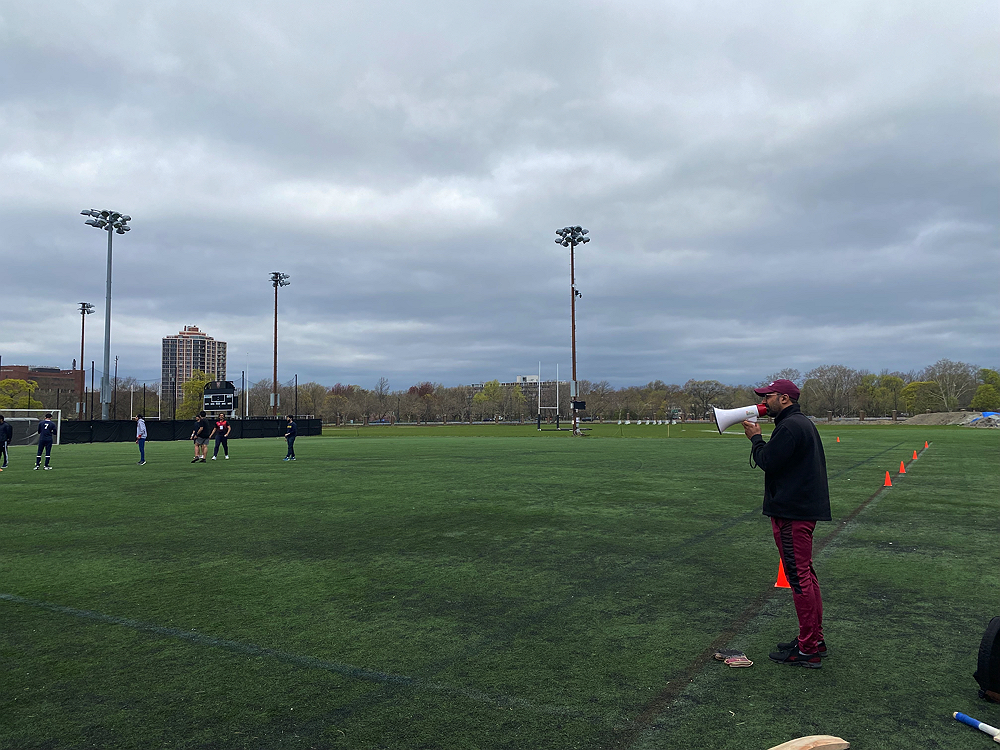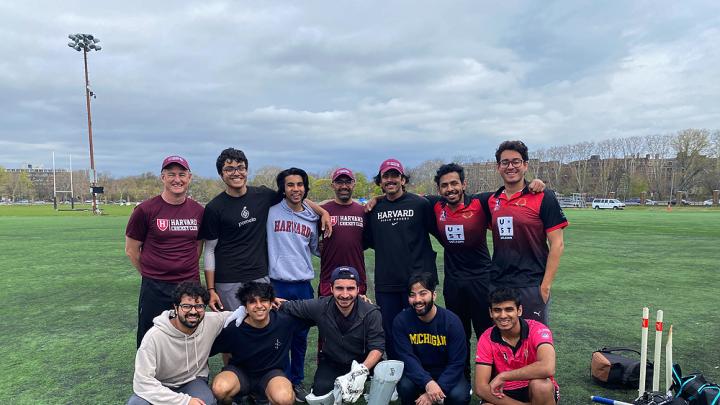For Harvard cricket players, each match begins with a calculation. The University has no cricket pitch, so the organizers must determine how to make do on Cumnock Field II, a synthetic lacrosse field. If the confines are too short or narrow, it will be too easy to score. Though cricket is usually played on an oval, a rectangle will have to suffice.
On a Sunday morning in late April, four undergraduates surveyed the grounds. They walked to different corners, pointed into the distance, and determined a passable arrangement. But once they laid down a series of orange cones to outline the field, the troubles continued: their Colgate opponents were running an hour late. Could the College and Kennedy School (HKS) teams still play a doubleheader during their six-hour field reservation?
Harvard cricket is no stranger to scrappiness. The club teams—one based in the College, another in HKS—argue they deserve more institutional support. But that won’t stop them from having a good time or from competing on collegiate cricket’s biggest stages.
For most players, the club is primarily a source of fun and a way to meet new people. Rohan Battula ’26 and Abdullah Shahid Sial ’27 arrived in Cambridge on the same flight from London this fall but didn’t get to know each other until they started playing cricket together. To Battula, a Londoner concentrating in computer science and economics, Harvard cricket is “more about loving the game and having fun than being competitive.”
Most Crimson cricket players grew up with the sport, hailing primarily from Commonwealth countries (including but not limited to Australia, England, India, Pakistan, South Africa, and Sri Lanka). The squad for the match against Colgate was entirely international. During the game, the players chirped at each other a bit in English, but primarily in Hindi and Urdu. “It’s a great community, all these brown boys together,” joked Abdullah Shahzad Qureshi ’24.
Though the casual American observer might not understand the rules or conversations, the fun is easily apparent. Says Sial, a Pakistani prospective economics and mechanical engineering concentrator, “Cricket has a lot of personality.”

That individual flair emerges most acutely from the bowlers, akin to baseball’s pitchers. Each bowler has a distinct motion. Ishan Tiwari ’25, for example, looked more like a dancer than a pitcher: the Nepalese mathematics and economics concentrator slicked back his flowing hair and stutter-stepped—a move that can only be described as a little jig. He ran forward, contorted his arm, and launched the hard ball toward the padded batsman from 22 yards away. Some bowled more simply, jogging at varied paces, while others resembled a galloping horse.
In the field, players defended with intensity. Whenever an opposing batsman made contact, the Harvard fielders erupted, calling for the ball and cheering the play. Tiwari and Ahmed Raza, M.P.A. ’24, slid on their knees, risking turf burn or torn sweatpants, but often saving the ball from bouncing out of bounds (which grants four runs).
The match had the feeling of an impassioned backyard wiffle ball game. There was no neutral umpire—that would cost the team $50, guesses Raza—but squabbles over disputed plays were quickly and civilly resolved. Toward the end of the first half-inning (about an hour long), Colgate realized that it was fairly easy to launch balls over the fence into the field hockey stadium. Hitting the ball out of bounds in the air yields six runs, the most possible with a single swing. Colgate cleared the fence so many times that their team designated a player to stay on the field hockey pitch and retrieve stray balls.
Harvard’s two cricket clubs are growing quickly. “When I first came in, we struggled to have 11 players for one game,” said Qureshi. “Today, we had 24 signups. It’s been very rewarding to see.”
This past winter, the Harvard Cricket Club traveled to Houston to compete in the NCAA National Championship. Some players lamented the lack of official support for their club. For students like Sial, who said he was on full financial aid, paying for flights can pose a budgetary burden. “Many other sporting clubs at Harvard are significantly better funded than us,” he said.
Raza, who founded the HKS team, hopes to see cricket continue to grow at Harvard after he graduates this spring. He plans to organize cricket-loving alumni and to lobby for more institutional support. But even in the club’s current state, with its broken stumps (wicket posts), borrowed equipment, and homemade customized sweatbands, the cricket matches still teleport players back to the fields of their youth—only this time, they are playing alongside an international crew of Crimson cricketers.








